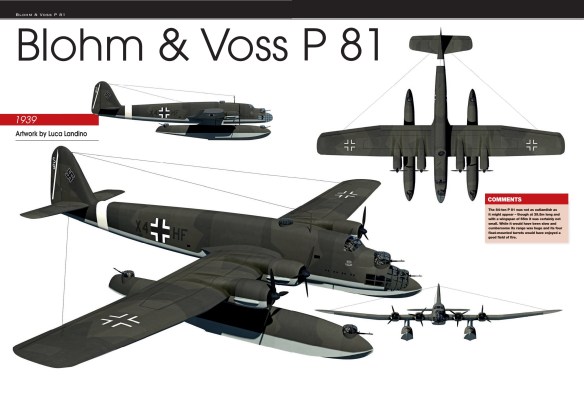The first BV 138 A-0s were completed in January 1939 but bad weather and other problems meant that test flying could only commence in June and “unfortunately, the results did not meet expectations. Blohm & Voss also had to make several changes to this aircraft before it could be flown by the E-Stelle”. Meanwhile, “at this time, Blohm & Voss, at the suggestion of the Generalluftzeugmeister [Ernst Udet], engaged in the further development of the remote reconnaissance machine.
The company’s response to Generalluftzeugmeister Ernst Udet’s suggestion for a much longer-ranged reconnaissance machine than the BV 138 took the form of two floatplane designs – the P 81 and the P 84. The P 81 was very large – somewhat resembling a scaled-up BV 140 with a BV 222 tail, it was 39.5m long, had a 55m wingspan, weighed 84 tons and had a range of 12,200km. Powered by four Jumo 218s – each one a linked pair of Jumo 208s – it was protected by turrets both at the bow and stern of its floats, plus both nose and dorsal turrets. The P 84 was similar in form to the P 81 but scaled down somewhat. It was 33.75m long, had a 46m wingspan, weighed 71 tons and had a range of 10,000km. It was also powered by four Jumo 218s. Given DLH’s ongoing need for transatlantic passenger transports, Blohm & Voss also presented two civilian designs based on the same large floatplane template – the P 85 and P 86. The P 85, a relatively straightforward passenger aircraft with a cylindrical fuselage, had a 46m wingspan but other details are unavailable from the E-Stelle report. The official Blohm & Voss project list confirms that it was powered by four Jumo 218s and weighed 68 tons.
The P 86, described as a high-altitude transatlantic passenger aircraft, was unusual in being a double decker – with passengers seated on two levels. This aircraft was 37.4m long and had a wingspan, again, of 46m. Yet remarkably it weighed less than the other designs at 56.7 tonnes.
Dornier was also asked to chip in at Udet’s suggestion and evidently presented its P 133, “a flying boat with 6 Jumo 208 engines and a flying weight of 58 tons at 8150 km range”. Unfortunately no drawing of the P 133 is known to have survived. None of the Udet-commissioned projects went anywhere “because there were no corresponding tactical demands that justify the construction of such aircraft, the procurement of the planned engines was not present for the time being and the development effort seemed too large”.
